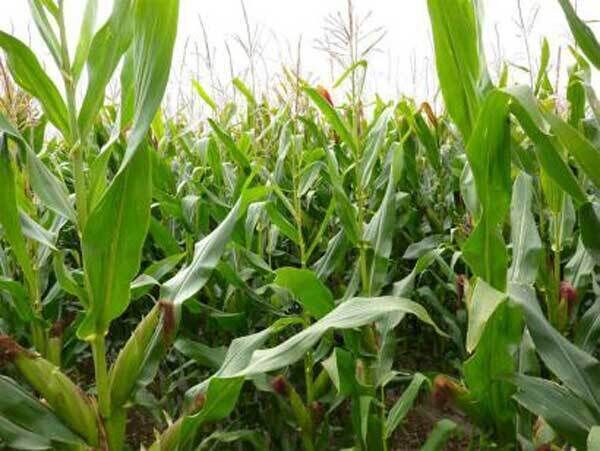May’s the month to get an earful of amazing maize

Zea mays var. saccharata— better known as sweetcorn — is a mutation of field maize, (plain old Zea mays) and yields more tender and sweeter kernels.
Both were possibly first domesticated in south America by the Olmecs and Mayan civilisations between 9,000BC and 8,000BC.
So if you’re seduced by the latest trendy buzz — ancient grains — look no further.
Maize is beginning to rise in appreciation as a gluten-free cereal (ideal if you have coeliac disease) and is now a favourite among clean eaters and those on a gluten-free diet.
In terms of clean agriculture, it is not residue-free (big farms use sprays), so growing your own is well worth the effort.
In a health-conscious world where we are trying to transition from sugary snacks to healthy bites, sweetcorn has a nice sweetness that knocks the rabbit food-aversion excuse on the head.
And while sweet, it is not tooth-meltingly so.

An ear of corn has a good calorific value — roughly about the same number of calories as an apple — but only a quarter of the sugar content of an apple.
It is still a bit high on the glycemic index but the fiber and phytonutrients it holds can slow the glycemic load.
Like an apple, it too can keep the doctor away. Like other yellow foods, corn is packed with phenolic flavonoid pigments which to the human physiology are antioxidant.
These pigments, such as ß-carotenes, lutein, xanthins, and cryptoxanthin, not only help us top up on vitamin A, but are very beneficial to eye health and great in slowing macular degeneration.
The purple varieties are equally beneficial. Foods rich in flavonoids are not only antiaging but are potentially anti-cancer.
The anti-cancer value is further boosted in sweetcorn by the presence of ferulic acid, which according to a 2004 Italian study, exerts a more powerful antioxidant action than both ascorbic acid (vitamin C) and alpha-tocopherol (vitamin E).
Ferulic acid is an ingredient in some skin care products to diminish wrinkles and blemishes so whatever about corn on the cob, corn on the mush might see you right.

One medium-sized ear contains almost 3.5g of protein and around 2g-3g of fibre.
We are not getting enough fibre — and if you are a juice freak (beg your pardon), then you are mushing the dietary fiber to nothing — we need the fiber to extract excess sugars and other gunge on the way out and we need it to feed the bacteria in our gut.
That mix of fiber and protein help moderate digestion rates and as anyone with a digestive complaint knows, a too rapid or too slow digestion is the root of all ills.
Sweetcorn is full of folic acid (great for anyone about to become a mummy) and also contains good quantities of B vitamins and vitamin C — that combo helps the body process protein efficiently and is key to the production of red blood cells and the protection of nerves and signaling mechanisms in the body.
There is also a supply of zinc, magnesium, copper, iron, and manganese all beneficial to optimum health.
So how to grow corn
You can start from seed or pick up a plug pack from your local garden center.
Either way, the positioning is vital, because they are wind pollinated it is best to plant/sow, 45cm apart in a staggered block rather that straight lines.
This way you are sure of pollen on the breeze hitting a target — 45cm apart ensures that.
The other consideration is the placement in the garden — best if in free-draining soil with full sun, better again if protected from the strong wind — sure, we want pollination, but not root rock.
Fear not if you are more dapple than full sun, there are shady cultivars (‘early bird’ and ‘sparrow’ to name two).
Corn can grow taller than the tall bloke down the road (often to two metres, hence its use in corn mazes) but there are a range of cultivars in varying heights, degrees of sweetness and maturation rates.

The first harvest is generally around 80 days after germination. The telltale signal is the silk tassel turns brown — the more chocolatey the riper.
But to be sure to squeeze or stick a thumbnail into a grain — if it squirts water it is unripe.
If it leaks a milky substance, it’s good to go. Simply twist the cob off rather than pluck.
Corn doesn’t store well or, more to the point, the quicker it is steamed or cooked or consumed raw the more nutrients stay bioavailable.
That’s the great thing about growing your own, you know its fresh — you taste the freshness and reap that reward.
In its husk, it can keep for about 3-4 days, out of husk just two days in a fridge — past that is past optimum.
If you are direct sowing (as some packets suggest) it might be a good idea to cloche over — as it does need a minimum of 10 degrees to germinate and the sweeter varieties need closer to 15 degress.
I always start mine indoors a the end of April or start of May (generally one week to 10 days to germinate), and move the seedlings out now. It is all good to start now.
The idea is after frost has passed. The seed needs light to germinate so don’t bury the buggers. Vermiculite is great for this complication. I find it a good decision to pre-soak seed overnight.

I have had good success with ‘lark’ and ‘swift’— I know, what’s with all the bird names.
You could also find ‘Golden Giant’, ‘Sundance’, or ‘Extra Tender and Sweet’ useful choices — if they’re not off training for the grand national.
All varieties like a fertile site. Manure if you can in advance.
They do like a deep soil too. Ideal for a raised bed which is also warmer than ground level at this time of the year.
They can be thirsty — so a watering regime is vital. I find a liquid comfrey feed really sturdy’s up plants and of course is beneficial to all fruiting plants.
In the Irish climate, you might only get 2-3 cobs off each stalk and that’s a small return compared to how much kale or potatoes you could harvest from the space they require.
But variety is the spice of life and growing what you eat is more important that a glut (food waste and all).
It’s good to try new things, it’s even better to have a varied diet. As a grower, two things I really like about sweetcorn is that they don’t have to be worked into any crop rotation system.
I can slot them in wherever I have space — in a different spot each year without worrying too much about it — and I haven’t experienced any pest or disease problems so far (about seven years growing them at this point).
So well worth a trial run.









